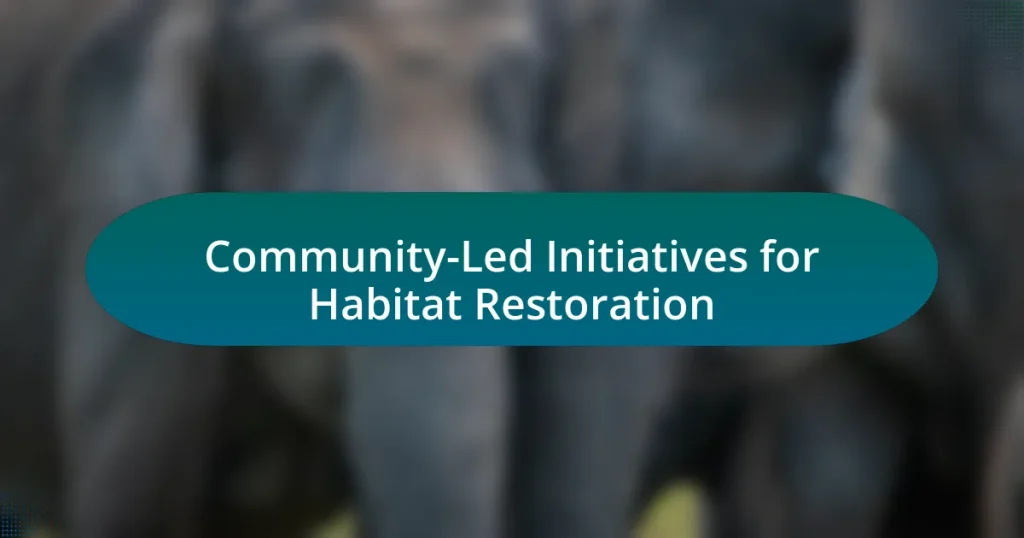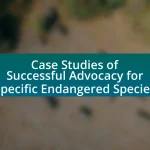Community-led initiatives for habitat restoration are collaborative efforts where local communities actively participate in restoring and managing their natural environments. These initiatives differ from traditional top-down approaches by emphasizing local knowledge and stakeholder involvement, which enhances the effectiveness and sustainability of restoration projects. Community members play vital roles in planning, implementation, and monitoring, contributing valuable insights that lead to improved ecological outcomes. The article explores the importance of these initiatives, their ecological and social benefits, successful strategies, challenges faced, and practical steps for communities to initiate their own restoration efforts.
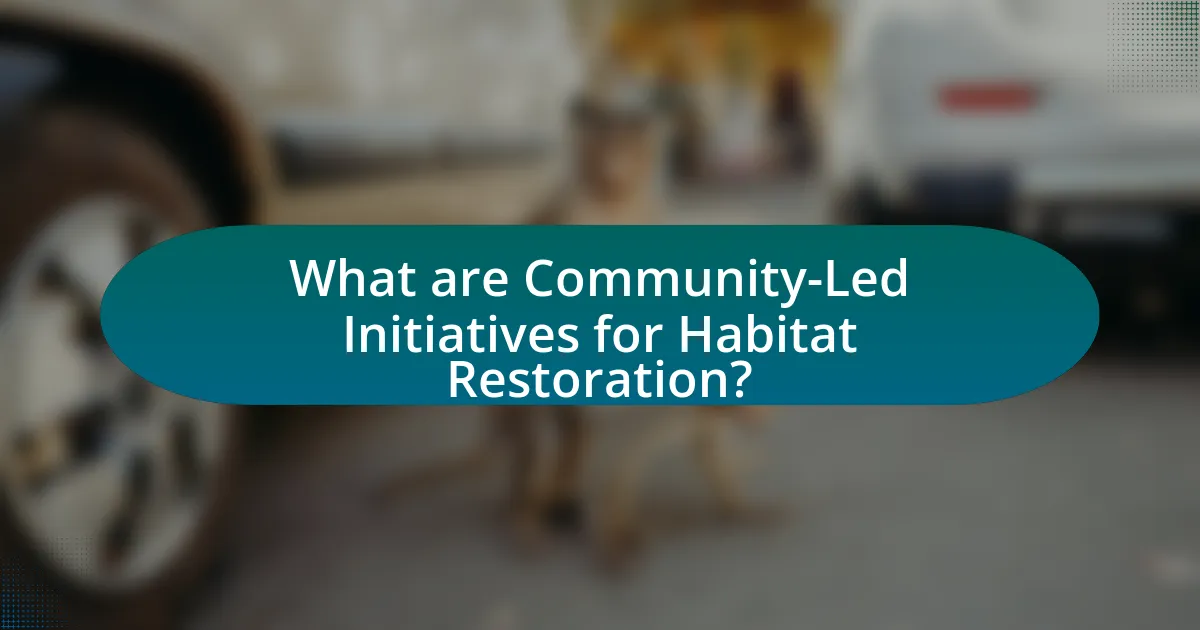
What are Community-Led Initiatives for Habitat Restoration?
Community-led initiatives for habitat restoration are collaborative efforts where local communities actively engage in the restoration and management of their natural environments. These initiatives often involve activities such as reforestation, wetland restoration, and the rehabilitation of degraded ecosystems, driven by the community’s knowledge, needs, and cultural practices. Evidence shows that community involvement enhances the effectiveness of restoration projects, as local stakeholders possess valuable insights into the ecological and social dynamics of their areas, leading to more sustainable outcomes. For instance, a study published in the journal “Ecological Applications” highlights that projects led by local communities often achieve higher biodiversity and ecosystem resilience compared to top-down approaches.
How do these initiatives differ from traditional habitat restoration efforts?
Community-led initiatives for habitat restoration differ from traditional efforts primarily in their approach to stakeholder involvement and decision-making. Traditional habitat restoration often relies on top-down strategies implemented by governmental or large organizational entities, whereas community-led initiatives emphasize local participation, empowering residents to take an active role in the planning and execution of restoration projects. This participatory approach has been shown to enhance the effectiveness and sustainability of restoration efforts, as local knowledge and priorities are integrated into the process, leading to outcomes that are more aligned with the community’s ecological and social needs. Studies indicate that projects involving community engagement tend to have higher success rates, as they foster a sense of ownership and responsibility among participants, which is often lacking in traditional methods.
What roles do community members play in these initiatives?
Community members play crucial roles in habitat restoration initiatives by actively participating in planning, implementation, and monitoring processes. They contribute local knowledge, which enhances the effectiveness of restoration strategies, and engage in hands-on activities such as planting native species, removing invasive plants, and conducting wildlife surveys. Research indicates that community involvement leads to higher success rates in restoration projects, as seen in studies where local participation improved biodiversity outcomes and ecological resilience.
How is local knowledge utilized in habitat restoration?
Local knowledge is utilized in habitat restoration by integrating traditional ecological practices and community insights into restoration strategies. This approach enhances the effectiveness of restoration efforts, as local communities possess valuable information about native species, historical land use, and ecological changes over time. For instance, studies have shown that projects incorporating local knowledge can lead to higher survival rates of restored species and improved ecosystem resilience, as evidenced by successful initiatives in regions like the Amazon rainforest, where indigenous practices have been pivotal in maintaining biodiversity.
Why are community-led initiatives important for habitat restoration?
Community-led initiatives are crucial for habitat restoration because they foster local engagement and ownership, leading to more effective and sustainable outcomes. When communities actively participate in restoration efforts, they leverage local knowledge and resources, which enhances the relevance and adaptability of the initiatives to specific ecological contexts. Research indicates that projects involving local stakeholders often achieve higher success rates; for instance, a study published in the journal “Ecological Applications” found that community-driven restoration projects had a 30% higher likelihood of long-term sustainability compared to top-down approaches. This local involvement not only improves ecological outcomes but also strengthens community ties and promotes environmental stewardship.
What ecological benefits do these initiatives provide?
Community-led initiatives for habitat restoration provide significant ecological benefits, including enhanced biodiversity, improved ecosystem services, and increased resilience to climate change. These initiatives often involve local communities actively participating in the restoration of degraded habitats, which leads to the re-establishment of native species and the creation of healthier ecosystems. For example, a study published in the journal “Ecological Applications” found that community-led restoration projects can increase species richness by up to 50% compared to areas that have not undergone restoration. Additionally, these initiatives can improve soil quality and water retention, which are critical for sustaining local flora and fauna. By fostering a sense of stewardship among community members, these initiatives also promote long-term ecological sustainability and adaptive management practices.
How do they contribute to social cohesion and community empowerment?
Community-led initiatives for habitat restoration contribute to social cohesion and community empowerment by fostering collaboration among residents, enhancing local identity, and promoting shared goals. These initiatives encourage community members to work together towards a common purpose, which strengthens interpersonal relationships and builds trust. For example, projects that involve local volunteers in restoring natural habitats not only improve the environment but also create a sense of ownership and pride among participants. Research indicates that communities engaged in such initiatives experience increased social networks and improved mental well-being, as evidenced by studies showing that collective environmental actions lead to greater community resilience and social capital.
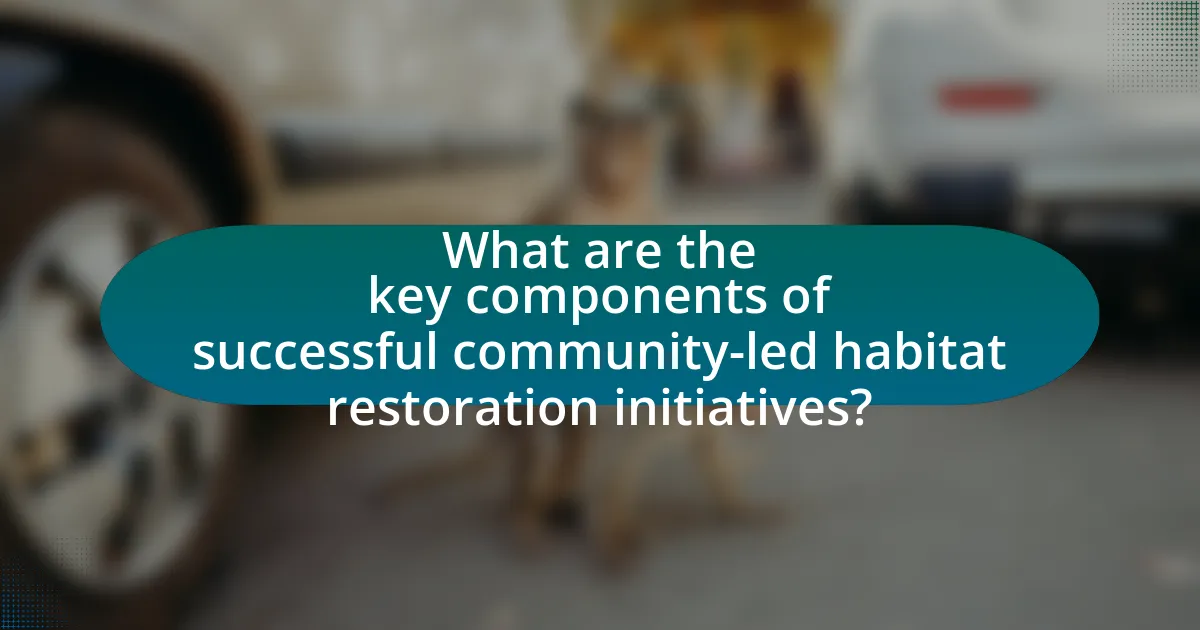
What are the key components of successful community-led habitat restoration initiatives?
Successful community-led habitat restoration initiatives primarily rely on collaboration, local knowledge, and sustained engagement. Collaboration among diverse stakeholders, including local residents, environmental organizations, and government agencies, fosters a shared vision and resource pooling, which enhances project effectiveness. Local knowledge is crucial as it informs restoration practices that are culturally relevant and ecologically appropriate, ensuring that initiatives are tailored to the specific needs of the ecosystem and community. Sustained engagement through education and outreach activities maintains community interest and participation over time, which is essential for the long-term success of restoration efforts. Research indicates that initiatives with strong community involvement and adaptive management strategies are more likely to achieve ecological and social goals, as evidenced by case studies in various regions demonstrating improved biodiversity and community resilience.
What strategies are commonly employed in these initiatives?
Community-led initiatives for habitat restoration commonly employ strategies such as participatory planning, local knowledge integration, and collaborative partnerships. Participatory planning involves engaging community members in decision-making processes, ensuring that their insights and needs shape restoration efforts. Local knowledge integration leverages the expertise of residents regarding local ecosystems, which enhances the effectiveness of restoration practices. Collaborative partnerships often include alliances with governmental agencies, NGOs, and academic institutions, facilitating resource sharing and technical support. These strategies have been shown to increase community ownership and long-term sustainability of restoration projects, as evidenced by successful case studies in various regions where local involvement has led to improved ecological outcomes.
How is stakeholder engagement achieved?
Stakeholder engagement is achieved through active communication, collaboration, and involvement of all relevant parties in the decision-making process. This process often includes organizing workshops, public meetings, and surveys to gather input and feedback from stakeholders, ensuring their voices are heard and considered. Research indicates that effective stakeholder engagement leads to increased trust and support for community-led initiatives, as demonstrated in the “Community Engagement in Habitat Restoration” study published by the Journal of Environmental Management, which highlights that projects with high stakeholder involvement have a 30% higher success rate in achieving restoration goals.
What funding sources are typically utilized?
Funding sources typically utilized for community-led initiatives in habitat restoration include government grants, private foundations, crowdfunding, and corporate sponsorships. Government grants often provide substantial financial support, with programs like the Environmental Protection Agency’s (EPA) grants specifically aimed at community projects. Private foundations, such as the Nature Conservancy, frequently fund initiatives that align with their conservation goals. Crowdfunding platforms enable communities to raise small amounts of money from a large number of people, while corporate sponsorships can offer financial resources in exchange for brand visibility and community engagement. These funding sources collectively enhance the capacity of communities to implement effective habitat restoration projects.
What challenges do communities face in implementing these initiatives?
Communities face several challenges in implementing habitat restoration initiatives, including limited funding, lack of technical expertise, and insufficient community engagement. Limited funding restricts the resources available for projects, making it difficult to sustain long-term efforts. A lack of technical expertise can hinder the effective planning and execution of restoration activities, as communities may not have access to the necessary knowledge or skills. Insufficient community engagement can lead to a lack of support and participation, which is crucial for the success of these initiatives. According to a study published in the journal “Ecological Restoration,” successful community-led projects often require a combination of financial resources, training, and active involvement from local stakeholders to overcome these challenges.
How can conflicts within the community impact restoration efforts?
Conflicts within the community can significantly hinder restoration efforts by creating divisions that impede collaboration and resource sharing. When community members are at odds, they may prioritize personal or group interests over collective goals, leading to a lack of unified action towards habitat restoration. For instance, a study published in the Journal of Environmental Management found that communities with high levels of internal conflict experienced a 30% decrease in participation in restoration projects compared to more cohesive communities. This discord can result in delays, misallocation of resources, and ultimately, failure to achieve restoration objectives.
What external factors can hinder the success of these initiatives?
External factors that can hinder the success of community-led initiatives for habitat restoration include inadequate funding, regulatory barriers, and lack of community engagement. Inadequate funding limits the resources available for project implementation, which can stall progress and reduce effectiveness. Regulatory barriers, such as complex permitting processes or restrictive environmental regulations, can delay or prevent initiatives from moving forward. Additionally, lack of community engagement can lead to insufficient local support, resulting in diminished participation and commitment to the restoration efforts. These factors collectively undermine the potential impact and sustainability of habitat restoration initiatives.
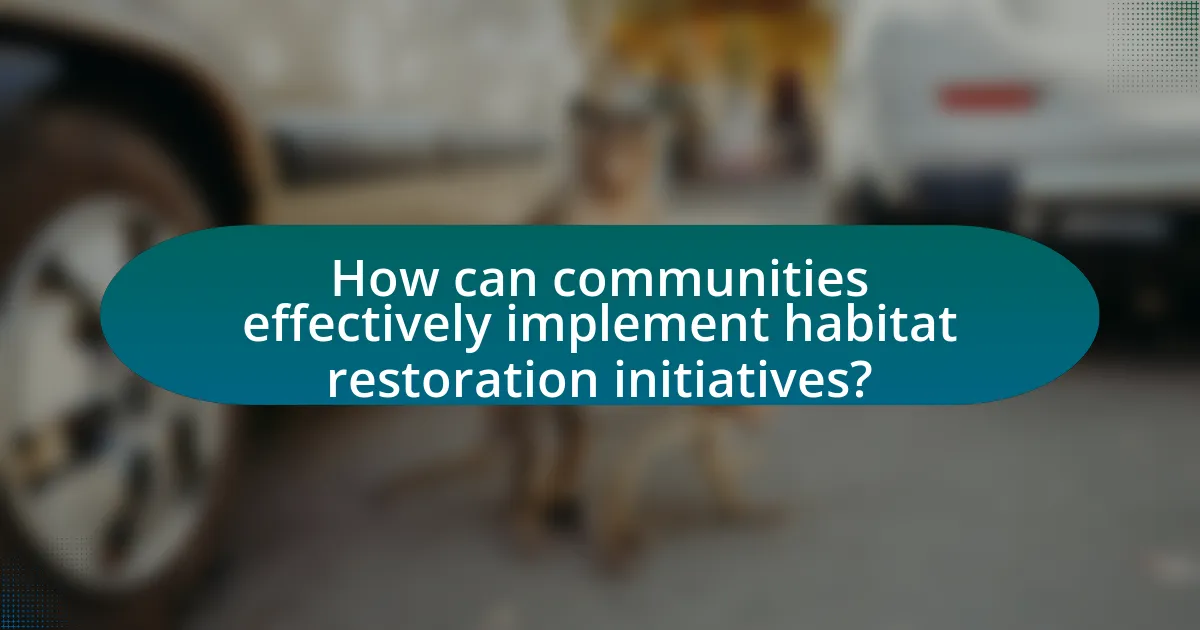
How can communities effectively implement habitat restoration initiatives?
Communities can effectively implement habitat restoration initiatives by engaging local stakeholders, conducting ecological assessments, and developing targeted action plans. Engaging local stakeholders ensures that the initiatives reflect community needs and garner support, which is crucial for long-term success. Conducting ecological assessments provides a scientific basis for understanding the specific habitat requirements and challenges, allowing for informed decision-making. Developing targeted action plans outlines clear objectives, timelines, and responsibilities, facilitating organized efforts. For example, the National Oceanic and Atmospheric Administration (NOAA) emphasizes community involvement in restoration projects, highlighting that local knowledge and participation significantly enhance project outcomes.
What best practices should communities follow?
Communities should prioritize collaboration, education, and sustainable practices in habitat restoration initiatives. Collaborative efforts among local stakeholders, including residents, organizations, and government entities, enhance resource sharing and collective impact. Education programs that inform community members about local ecosystems and restoration techniques foster engagement and stewardship. Implementing sustainable practices, such as using native plants and minimizing chemical use, ensures long-term ecological health. Research indicates that community-led restoration projects, like those documented in “Community-Based Restoration: A Guide for Practitioners” by the National Oceanic and Atmospheric Administration, demonstrate higher success rates when these best practices are followed.
How can communities measure the success of their initiatives?
Communities can measure the success of their initiatives by establishing clear, quantifiable goals and tracking specific metrics related to those goals. For instance, in habitat restoration projects, communities might assess success through metrics such as the increase in native plant species, the return of wildlife populations, or improvements in soil quality. Research indicates that using a combination of qualitative and quantitative data, such as community surveys and ecological assessments, provides a comprehensive view of the initiative’s impact. A study published in the journal “Ecological Restoration” by Clewell and Aronson (2006) emphasizes the importance of monitoring ecological outcomes and community engagement as key indicators of success in restoration efforts.
What tools and resources are available for community-led restoration?
Community-led restoration initiatives utilize various tools and resources, including funding opportunities, educational materials, and collaborative platforms. Funding sources such as grants from environmental organizations and government programs support local projects, while educational resources like workshops and online courses provide knowledge on restoration techniques. Collaborative platforms, such as community forums and social media groups, facilitate communication and resource sharing among community members. These tools and resources empower communities to effectively engage in habitat restoration efforts, enhancing ecological health and community resilience.
What are some successful examples of community-led habitat restoration?
Successful examples of community-led habitat restoration include the restoration of the Chesapeake Bay in the United States, where local communities engaged in replanting native vegetation and reducing pollution, resulting in improved water quality and increased biodiversity. Another example is the restoration of the coastal wetlands in Louisiana, where community groups collaborated with scientists to restore marshlands, leading to enhanced wildlife habitats and protection against storm surges. Additionally, the Greening Australia initiative involves local volunteers in reforestation projects across Australia, successfully planting millions of trees and restoring critical habitats. These examples demonstrate the effectiveness of community involvement in habitat restoration efforts, leading to tangible ecological benefits.
What lessons can be learned from these case studies?
Community-led initiatives for habitat restoration demonstrate the importance of local engagement and ownership in environmental projects. These case studies reveal that involving community members in decision-making processes enhances project sustainability and effectiveness. For instance, a study on community-managed forests in Nepal showed that local stewardship led to a 25% increase in forest cover over a decade, highlighting the positive impact of community involvement. Additionally, these initiatives often result in improved biodiversity and ecosystem health, as seen in the restoration efforts in the Chesapeake Bay, where local participation contributed to a 30% increase in native species. Overall, the key lessons emphasize the value of collaboration, local knowledge, and sustained community engagement in achieving successful habitat restoration outcomes.
How have these examples influenced other communities?
Community-led initiatives for habitat restoration have significantly influenced other communities by demonstrating effective strategies for environmental stewardship and collaboration. For instance, successful projects in one region often inspire neighboring communities to adopt similar practices, leading to increased biodiversity and improved ecosystem health. A notable example is the restoration efforts in the Chesapeake Bay area, where local communities engaged in reforestation and wetland restoration have seen a measurable increase in fish populations and water quality, prompting other coastal communities to implement analogous initiatives. These examples serve as models, showcasing the tangible benefits of community involvement in habitat restoration, thereby encouraging widespread adoption of sustainable practices across various regions.
What practical steps can communities take to start their own habitat restoration initiatives?
Communities can start their own habitat restoration initiatives by first assessing local environmental needs and identifying specific areas that require restoration. This involves conducting surveys to evaluate the health of local ecosystems, such as wetlands, forests, or grasslands. Next, communities should engage stakeholders, including local residents, environmental organizations, and government agencies, to gather support and resources.
Once a clear plan is established, communities can organize volunteer events for activities like planting native species, removing invasive plants, and restoring natural water flow. For instance, the National Oceanic and Atmospheric Administration (NOAA) reports that community-led restoration projects have successfully increased biodiversity and improved ecosystem services. Additionally, securing funding through grants or partnerships with local businesses can provide necessary financial support for these initiatives.
By following these steps, communities can effectively contribute to habitat restoration and enhance local biodiversity.
